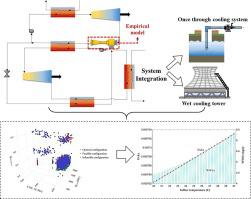当前位置:
X-MOL 学术
›
Energy Convers. Manag.
›
论文详情
Our official English website, www.x-mol.net, welcomes your
feedback! (Note: you will need to create a separate account there.)
An integrated steam jet ejector power plant for drought adaptation considering water-exergy nexus in an optimal platform
Energy Conversion and Management ( IF 9.9 ) Pub Date : 2021-01-01 , DOI: 10.1016/j.enconman.2020.113622 Pouya Ifaei , Usman Safder , Amir Saman Tayerani Charmchi , ChangKyoo Yoo
Energy Conversion and Management ( IF 9.9 ) Pub Date : 2021-01-01 , DOI: 10.1016/j.enconman.2020.113622 Pouya Ifaei , Usman Safder , Amir Saman Tayerani Charmchi , ChangKyoo Yoo

|
Abstract Steam power plants contribute to anthropogenic climate change by emitting a considerable amount of carbon dioxide and losing significant freshwater. In the present study, a novel model-based steam jet ejector power plant is optimally designed to adapt to climate change by minimizing water losses and greenhouse emissions. An iterative thermo-mathematical program and a nonlinear mathematical model represent the system's energy and economic models. At the same time, an exergy analysis evaluates its performance according to the Second law of thermodynamics. A non-dominated sorting genetic algorithm generation III is interfaced with the developed empirical program to solve a multi-objective optimization model. Three decision-making scenarios including a maximum thermal efficiency (I), minimum cost of energy (II), and minimum heat losses (III) are considered to select appropriate configurations in the final Pareto front. Subsequently, a natural draft wet cooling tower and a once-through cooling system are coupled with the optimal configurations. The performance of the fully-integrated systems is evaluated using four new water-exergy nexus criteria including water withdrawal for exergy dissipation, lost exergy for exergy dissipation, water consumption for fuel and product exergies. Finally, a sensitivity analysis is performed to take the environmental fluctuations and model uncertainties into account. The comparative results showed that water consumption for product and fuel exergies improved by 63.65 and 64.08%, while water withdrawal for exergy dissipation of the system was approximately nine times smaller than available model-based steam power plants. Moreover, the energy efficiency of the proposed system was 1.42% greater than the previous systems at the cost of 0.018 $/MJ more cost of energy. Thus, the proposed system can tackle drought and mitigate climate change with more investment in the energy sector.
中文翻译:

考虑水-火用关系的优化平台适应干旱的集成蒸汽喷射器发电厂
摘要 蒸汽发电厂通过排放大量二氧化碳和大量淡水流失导致人为气候变化。在本研究中,一种基于模型的新型蒸汽喷射器发电厂经过优化设计,通过最大限度地减少水损失和温室气体排放来适应气候变化。迭代热数学程序和非线性数学模型代表系统的能源和经济模型。同时,火用分析根据热力学第二定律评估其性能。非支配排序遗传算法第三代与开发的经验程序接口,以解决多目标优化模型。三种决策方案,包括最大热效率 (I)、最低能源成本 (II)、和最小热损失 (III) 被认为是在最终的帕累托前沿中选择合适的配置。随后,自然通风湿式冷却塔和直流冷却系统与最佳配置相结合。使用四个新的水-火用关联标准评估完全集成系统的性能,包括用于火用耗散的取水、用于火用耗散的火用损失、燃料和产品的耗水量。最后,进行敏感性分析以考虑环境波动和模型不确定性。比较结果表明,产品和燃料火用的耗水量分别提高了 63.65% 和 64.08%,而系统火用耗散的取水量比现有的基于模型的蒸汽发电厂小了大约 9 倍。此外,拟议系统的能源效率比以前的系统高 1.42%,但能源成本增加了 0.018 美元/兆焦耳。因此,拟议的系统可以通过对能源部门的更多投资来应对干旱和减缓气候变化。
更新日期:2021-01-01
中文翻译:

考虑水-火用关系的优化平台适应干旱的集成蒸汽喷射器发电厂
摘要 蒸汽发电厂通过排放大量二氧化碳和大量淡水流失导致人为气候变化。在本研究中,一种基于模型的新型蒸汽喷射器发电厂经过优化设计,通过最大限度地减少水损失和温室气体排放来适应气候变化。迭代热数学程序和非线性数学模型代表系统的能源和经济模型。同时,火用分析根据热力学第二定律评估其性能。非支配排序遗传算法第三代与开发的经验程序接口,以解决多目标优化模型。三种决策方案,包括最大热效率 (I)、最低能源成本 (II)、和最小热损失 (III) 被认为是在最终的帕累托前沿中选择合适的配置。随后,自然通风湿式冷却塔和直流冷却系统与最佳配置相结合。使用四个新的水-火用关联标准评估完全集成系统的性能,包括用于火用耗散的取水、用于火用耗散的火用损失、燃料和产品的耗水量。最后,进行敏感性分析以考虑环境波动和模型不确定性。比较结果表明,产品和燃料火用的耗水量分别提高了 63.65% 和 64.08%,而系统火用耗散的取水量比现有的基于模型的蒸汽发电厂小了大约 9 倍。此外,拟议系统的能源效率比以前的系统高 1.42%,但能源成本增加了 0.018 美元/兆焦耳。因此,拟议的系统可以通过对能源部门的更多投资来应对干旱和减缓气候变化。











































 京公网安备 11010802027423号
京公网安备 11010802027423号